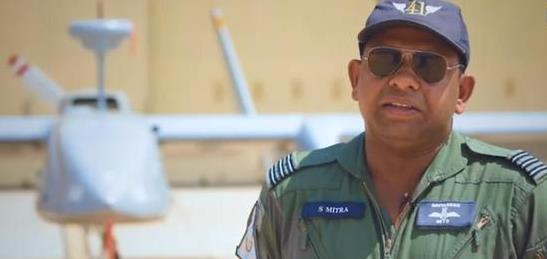Indian UAV operator badges and logos are very attractive
On July 3, Indian television broadcast a picture of prime minister modi receiving local troops in Ladakh. From the picture, it can be seen that many pilots were among the people received. Among them, the badge and logo on one pilot was very eye-catching. His chest badge showed that he was a drone operator, while his hat and abdominal badge had never been made public, which made his troops a mystery.
Pay attention to the UAV operator behind, and the pilot MIG 29 of the 47th squadron in front
At present, the UAVs equipped by the Indian army are mainly medium-sized and small UAVs, and there is no large UAV for the time being. In terms of types, they are mainly reconnaissance UAVs, and there are no observation and combat integrated UAVs like rainbow series and pterodactyl series.

Among these UAVs, small tactical reconnaissance UAVs are mainly concentrated in the army, while medium-sized UAVs with long range have been monopolized by the Indian Air Force and navy. Therefore, the UAV troops appearing in Ladakh this time can only come from the Navy or air force.
In terms of UAV models, the Indian army mainly uses two Israeli UAVs. Among them, the largest number is the searcher UAV, which is a medium-sized reconnaissance UAV launched by IAI company in Israel since 1992. It has developed two generations in total, namely, the early searcher MK1 and the searcher MK2 launched in 1998. These two sub models are equipped by the Indian army, but the searcher MK2 is still used at present.
Searcher MK2 UAV is a rainbow 3 medium-sized UAV, but there is a big gap with rainbow 3 in terms of aerodynamic layout. It adopts the traditional upper single wing double tail support layout, while rainbow 3 is a wing body fusion and front canard wing design.
However, although the aerodynamic design is very different, the flight performance of the two is relatively similar. The searcher MK2 uses a 47 HP limbach l 550 engine, with a maximum flight speed of 200 km / h and a maximum practical ceiling of 6100 meters. Both of these performances are slightly weaker than rainbow 3.
In terms of task execution, the searcher MK2 can carry a 65 kg reconnaissance load to perform tasks. It is usually equipped with an optoelectronic pod with high-definition white light CCD channel, high-definition thermal imaging channel and laser ranging channel. It can also mount a synthetic aperture radar pod, mainly to perform reconnaissance and surveillance and artillery calibration tasks.
In front of the heron UAV equipped by the Indian army, behind it is the searcher MK2
Heron UAV
In addition to the searcher UAV, another UAV equipped by the Indian army is the heron UAV of IAI company. The aerodynamic design of this UAV is basically the same as that of the searcher MK2, but the streamlined body is better, and the size of the whole machine is larger. In addition, the Austrian Rotax 914 engine has greater horsepower, so the performance of heron is much better than that of the searcher MK2, Especially the plateau performance.
The maximum practical ceiling of heron has reached 10000 meters, and the maximum takeoff weight has also reached 1.15 tons, which means that it can carry more loads to carry out missions in plateau areas, and it is less affected by terrain. Since the ceiling of searcher MK2 is only more than 6000 meters, it is very uncomfortable to fly in Ladakh, because the average altitude of Ladakh is more than 4000 meters, and there are many snow mountains of fiveorsix kilometers.
Therefore, compared with the two, Heron is more suitable for the deployment in the plateau area. In fact, the photos taken by satellites and the sporadic exercise pictures of the Indian army before show that the heron UAV is deployed by the Indian army in Ladakh area.
Heron UAV in Liecheng base
Heron UAV appeared during the exercise in Ladakh area
In terms of quantity, the Indian army imported a total of about 172 searcher MK1, MK2 and Heron UAVs before and after. However, the 36 searcher MK1 imported as early as 1996 should have been retired long ago. Except for some damaged, scrapped, crashed and shot down by Pakistan in these years, the Indian army still uses about 100 to 120 searcher MK2 and Heron combined.
Except for those retained by the training unit, the other UAVs are organized into seven squadrons by the Indian Navy and air force, including four Squadrons (3001-3004 squadrons) of the air force and three squadrons (342-344 squadrons) of the Navy. Each squadron adopts the mixed method of searcher MK2 and Heron, but there should be only heron on the Ladakh plateau.
Look closely at this badge. There are two dolphins jumping outward
According to the satellite photos, the Indian army has deployed Heron UAVs to Lecheng since 2014, and the number is about 2 to 4. Moreover, Lecheng has also built a dedicated hangar for UAVs, but it is not clear whether these units are resident in Lecheng or are deployed in rotation.
In principle, the Indian army should be the deployed UAV unit of the air force in Liecheng, but the badge on the abdomen of the UAV operator in modi's interview with the picture shows that he may be from the Navy. Because there are obviously two dolphins jumping outward on the badge, it may be that after the reconnaissance demand increases, the UAV unit originally deployed in this place cannot undertake the required task volume, Therefore, the Indian army transferred the Navy's UAV units from the interior for reinforcement.
Recommended News
What are the techniques for making badges2021/7/5
How to maintain the metal badge without discoloration after years of electroplating?2022/2/8
A distinctive badge is moving2021/7/12
Licensed drivers in London must wear appropriate badges2021/6/28
The symbolic significance of foreign Royal insignia2021/4/13




